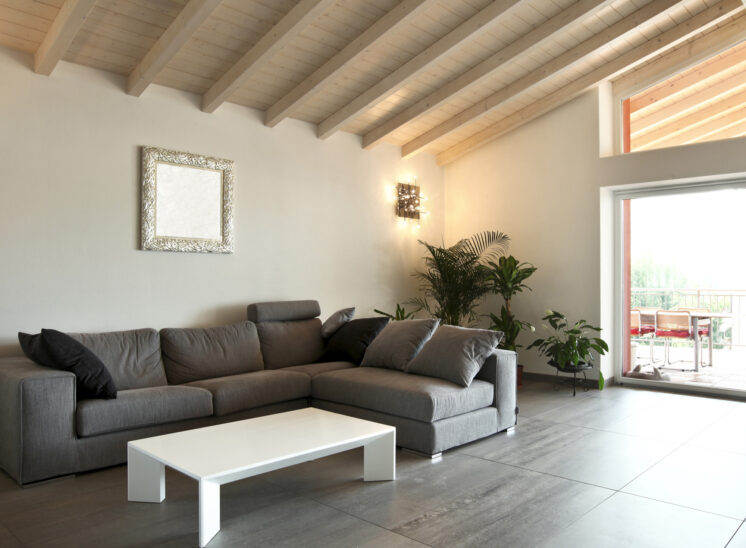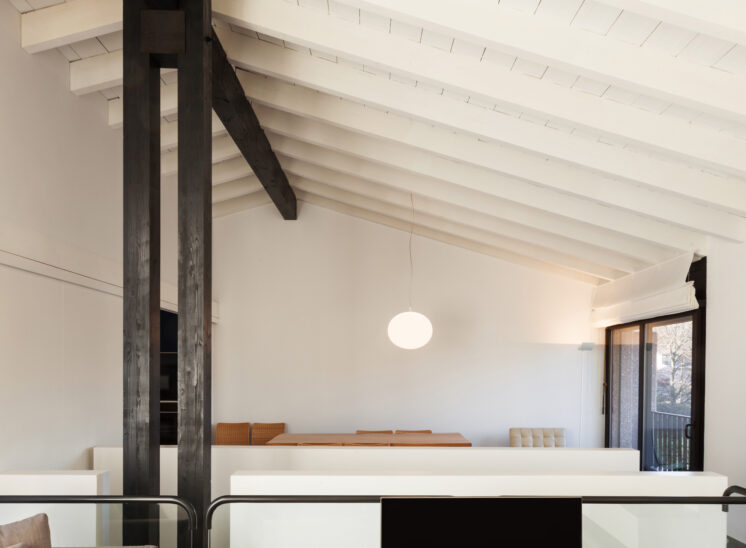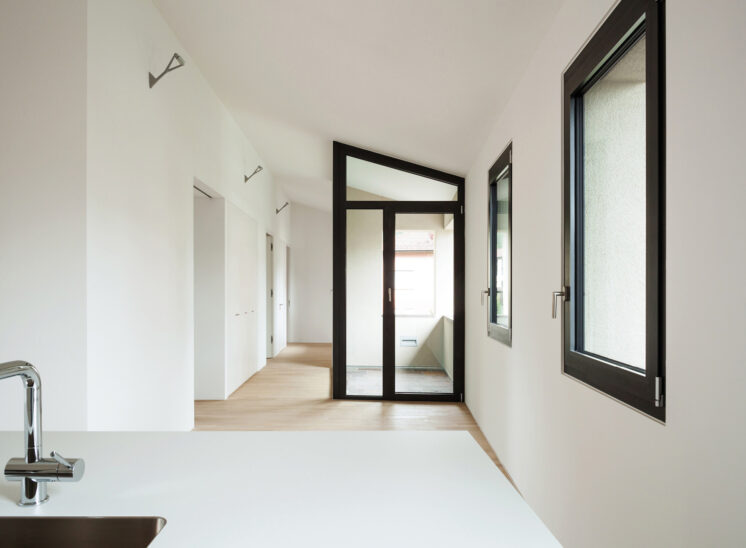Use of a mobile home in the garden of a residential house.
Siting a mobile home in a garden does not directly require planning but we advise applying for a ‘Certificate of Lawfulness’ from the Planning Authorities. This is essentially a letter from the Council confirming you don't need planning permission as your project doesn't involve development or change of use of the land.
IF YOU ARE PRE-PLANNING AND INTENDING TO USE A MOBILE HOME IN YOUR GARDEN WE STRONGLY RECOMMEND YOU GET AND FOLLOW THE PLANNING GUIDE AVAILABLE ON AMAZON (LINK BELOW)
https://www.amazon.co.uk/dp/152725755X/ref=olp_product_details?_encoding=UTF8&me=
Mobile homes in gardens: The planning guide tells you how to get extra living space - without needing planning permission -including:
-
little known about or understood principle of mobile homes in gardens
-
three most important factors in being able to put a mobile home in your garden
-
essential law you need to know
-
most common restrictions
-
how your proposal will be assessed by the council
-
where to place your mobile home
-
allowed uses of garden mobile homes
-
how to make the appropriate application
-
answers to the most common questions homeowners ask
This is the definite guide to mobile homes in domestic gardens without planning permission. It explains how it can be possible to circumvent council’s often encountered resistance to allowing homeowners the additional accommodation they need to accommodate elderly parents or grown-up children. The information is clearly presented and written in a highly accessible style, making a complex subject easily understandable to non-specialist householders. The guide contains a complete example mobile home application.
EXCERPTS:
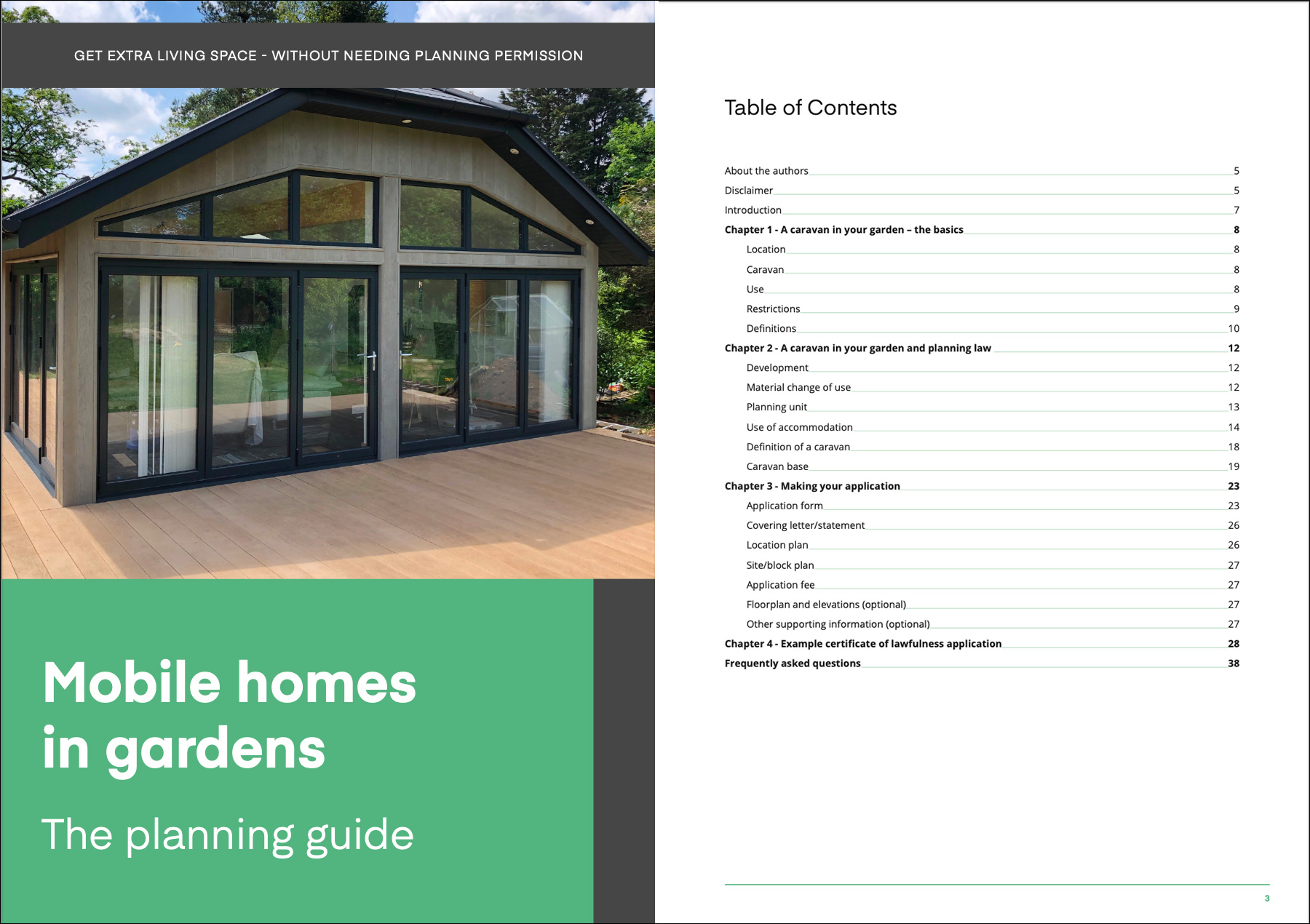
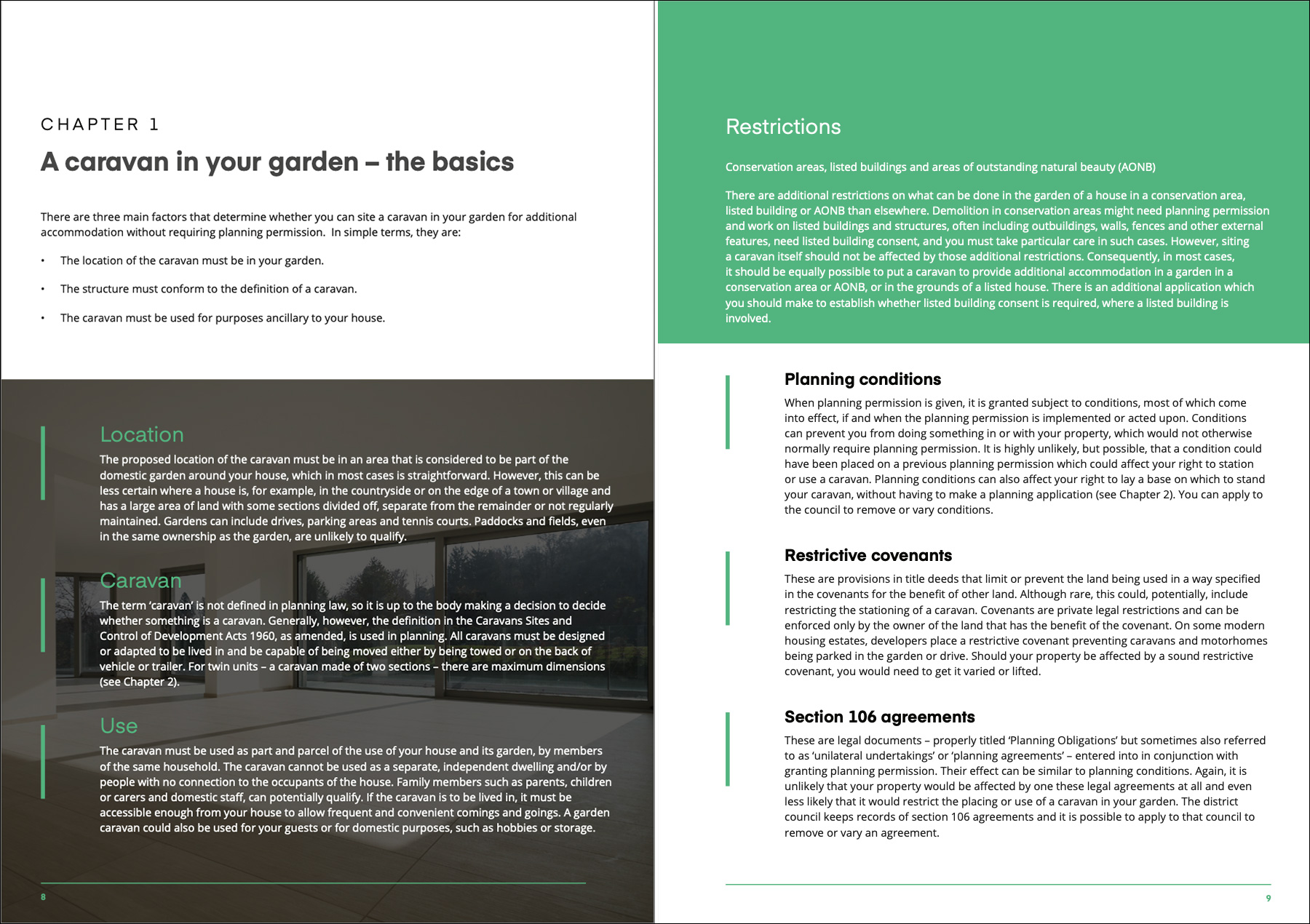

Introduction
Welcome to Mobile homes in gardens - The planning guide, the guide to using a mobile home or static caravan for additional residential accommodation in your garden, without needing planning permission.
There are several reasons why placing a structure, which comes within the legal definition of a caravan, in a domestic garden, is an increasingly popular way of creating additional space.
Firstly, the demand for housing and living space for grown-up children, ageing parents or other relatives is extremely high and the cost of buying a home is prohibitive for many. Secondly, planning policies and regulations often restrict or prevent extra living accommodation in gardens, such as an annexe building. Installing a mobile home is subject to different rules, which can – in the right circumstances and done the right way – avoid suchplanning restrictions. Thirdly, standard caravans and mobile homes lack architectural beauty and, in the past, provided low-quality living standards. However, modern designs and build methods can now offer all the luxury of a conventional construction.
It is surprising to many, including some council planning officers and councillors that the rules on planning permission relating to touring caravans (the type towed behind a car) also apply to mobile homes and static caravans, which can be significantly larger and suitable for year-round residential accommodation on a long-term or permanent basis. Generally speaking, if you can park a touring caravan on your drive, you should be able to have a large mobile home in your garden instead.
You might have seen mobile homes and static caravans being transported along the motorways and thought of the practical impossibility of delivering and placing such a structure in your own back garden, particularly because of access problems. This need not be the case. Mobile homes and caravans, even large ones, can be assembled on site where access is restricted.
Whilst all this might sound straightforward, there are various considerations, potential complexities and interpretations. Fortunately, the uncertainties can be reduced by making an application to the council for a formal certificate. This will establish whether, in your particular circumstances, you have the right to place a mobile home or static caravan in your garden to use for your intended purpose. We strongly recommend you obtain one of these certificates before proceeding with any project.
This guide takes you through the main issues involved in having a mobile home or static caravan in your garden. It will then show you how to make an application to the council.
You might expect all the issues involved to be well established and clear-cut. Sadly, this is not the case and there are various interpretations evident in decisions on applications to councils and appeal decisions. The approach set out in this book is based on our understanding and opinion and on our practical experience in this area, gained over many years.
This guide is based on law and regulations for England.
PLANNING GUIDE AVAILABLE ON AMAZON (LINK BELOW)
https://www.amazon.co.uk/dp/152725755X/ref=olp_product_details?_encoding=UTF8&me=
Habitats General Rules Guide for Mobile Homes in Gardens
(We recommend purchasing the Planning Guide linked above for a guide on how to obtain a Certificate of Lawfulness. The overview below is Habitats General Guide, not excerpts of the book above)
OVERVIEW
A caravan, be it a touring or static caravan or a large twin-size mobile home, is regarded as an article of movable personal property known as a ‘chattel’ and there is no public law preventing one being kept in someone’s garden, but there are Laws that regulate the ‘Use’ of land and ‘Development’.
The siting of a caravan within the garden of a property does not require express consent provided a ‘material change of use’ or ‘Development’ has not occurred. If a caravan is parked in a drive or sited in a garden and used by members of the household in connection to the enjoyment of the house or as extra accommodation for visiting guests, provided the occupants continue to use the facilities of the house, then the siting of the caravan has not changed the ‘use’ of the land. However, if for example a caravan is sited in a garden and used as business premises, separately rented or used as a primary independent dwelling, with no relation to the main house, the local planning Authority could decide that an unauthorized ‘material change of use’ has occurred, for which planning permission will be required.
The most important element is location. The location has to be in the direct garden, it can’t be on paddock land, or scrub land that is some distance from the house, even if the location is within the property boundary it really needs to be in the direct garden.
A mobile home can be used in a garden without planning but you will need to justify how the use of the caravan supports the use of the house and how it will not become a separate or independent dwelling. For example the people who sleep and wash in the mobile home will use the cooking facilities of the main house. The structure must also be located in the actual garden, not surrounding land. Caravans, including mobile homes up to 65x22ft, can be sited in the direct garden of a house without planning permission if they are used by members of the household as additional living space not as independent accommodation.
Key Factors
There are three key factors to determine whether siting a caravan in a garden will not require planning permission. They are; the location of the caravan is garden, the caravan itself conforms to the legal definition, the use of the caravan is functionally link to the house.
Location
The caravan must be in the ‘curtilage’ of a dwelling house. This is the drive or garden, not adjoining paddock land, for example.
In James v Secretary of State for the Environment 1990 it was held that there are three criteria for determining whether land is within the curtilage of a building, namely:
- physical layout
- ownership, past and present
- use or function, past and present
Definition of a ‘Caravan’
The actual structure must conform to the legal definition of a ‘caravan’ described in the Caravans Sites and Control of Development Acts 1960 and Associated Articles.
Appeal Decision by the Secretary of State (Erewash Borough Council 2002) determined that there are 3 tests to be applied to the park home:
- construction test
- mobility test
- size test
Use
The use must be incidental to the use of the house, meaning used in conjunction with. There are 4 accepted ‘incidental’ tests, reported to the House of Commons (Hansard, for 22 November 2005) as arising from relevant case law. These are:
- the relationship between the respective occupants
- the relative size of the house, its garden and the caravan
- the relative scale of accommodation in the caravan and the house
- the degree to which the caravan is functionally connected to and subordinate to the use of the dwelling house
Different Types of Caravan
The legal definition of a caravan covers a wider range of structures than conventional touring caravans. A ‘caravan’ is any structure designed for human habitation that is capable of being transported. The term ‘caravan’ applies to touring caravans, motorhomes, static caravans and twin-unit mobile homes and park homes.
Touring Caravans. These are the ones we see towed behind cars. Designed for occasional recreational use. They are built to BS EN 1645 and must meet the requirements for the construction and use of road vehicles.
Motor-caravans incorporate the living accommodation similar to that of a touring caravan onto a motor base vehicle and are therefore designed specifically for touring. They are built to BS EN 1646 and must be road legal.
Static caravans, also called holiday caravans and single units, are designed for recreational use not yearlong residential accommodation. They are not directly towed on roads but transported in one complete section on a HGV trailer. They are built to BS EN 1647.
Park Homes refers to single and double unit caravans designed for residential use and built to BS 3632.
Mobile homes refer to caravans that are designed for residential use and are not to be directly towed on roads by a vehicle. They do not have to meet any BS standards but they must meet the mobility and size test and additionally the construction test for twin units.
Common Questions
If I couldn’t drive a small car to my back garden, how would a massive 20 x 6 meter 5 bedroom mobile home be moved in and out?
Mobiles Homes can be assembled onsite from prefabricated panels and the mobility off-site and down a non-specific road is hypothetical.
This is best answered in ‘The Appeal Decision; Brightlingsea Haven Limited v. Morris 2008’ where it stated ‘It is the structure that must conform to the law not the means of access to where the structure actually is, and whether it may have difficulty in reaching a road.
It is now common practice to build or assemble caravans in hard to access back gardens. The structure must remain movable and capable of transport down a hypothetical road, even if access to a road may require craning over buildings or complicated procedures. The structure need not have direct access to a road to be deemed a ‘caravan’. In terms of construction, Mobile Homes can be assembled onsite from many prefabricated pieces so long as they conform to the construction and mobility test. Other caravans like touring and static caravans need not meet the construction tests but must remain movable. For large mobile homes it is recommended a kit-form caravan is purchased from a specialist reputable manufacturer as opposed to building one independently.
Why would I want to live in a Caravan? I’ve stayed in caravans at holiday parks; they look horrible and are freezing cold in the winter!
Many people think of mobile homes and static caravans as having substandard comfort, dreary designs and paper-thin walls. However, they are not all like this. Modern mobile homes can offer all the luxury of conventional residential living. They can be built to the same insulation values as a normal house and come in a variety of designs and styles.
How big can a ‘caravan’ be?
Although the maximum size of a caravan is limited to 20 x 6.8m in the Caravan Sites Acts, it is still considerably large, with enough space for over five bedrooms, toilets, kitchen and living spaces. A caravan can be significantly larger than most buildings capable of obtaining planning approval as annexes.
Why not just have outbuildings? Homeowners have rights to build outbuildings without planning permission. Why would I consider a Mobile Home?
Many homeowners are familiar with the ‘Permitted Development Right’ to have sheds and other outbuildings in a garden without the need for planning approval (The Town and Country Planning General Permitted Development Order 2008) . However, the development rights for outbuildings don’t allow living accommodation and a structure with a kitchen and bathroom is not allowed.
What’s the most common problem?
The main problem that occurs with the Local Authorities (if the boundary of the garden and compliance with the Caravans Sites Act is not in question) will be the argument that if the caravan has all the facilities for independent living it is therefor capable of being used as a separate dwelling and a separate planning unit will have been created. Consequently, the use of the land will have changed from a single dwelling or incidental to the enjoyment of the dwelling. However, this argument is not supported by Case Law. All caravans have the facilities for independent living by their very definition. There is no law that states that a caravan with full living facilities constitutes development. This applies more to buildings than caravans. One possibility to overcome this argument is to independently sign an ‘affidavit/statutory declaration’ stating that the use of the caravan will be not be as a separate dwelling.
What about farmland? Can I put a caravan in a field?
The answer is yes, but you can’t use the caravan as accommodation. It must be used in association with the use of the land. On farm land the caravan must be used for farming activities, storage or a rest area required by health and safely for workers. It cannot be used residentially as living accommodation without approval because the ‘use’ of the land would have changed from agricultural to domestic and a ‘material change of use’ would have occurred.
Should the Council be contacted?
You don’t have to contact the Council but it is recommended, especially in cases of large mobile homes. If all the circumstances are satisfied and Lawful, then you can get a letter of confirmation from the Council, either an informal reply to a letter or via an official Lawful Development Certificate, which involves completing the application documents.
Why not just apply for planning permission for an annexe?
Statistically there will be a high chance of refusal. When residential annexes are granted planning permission they are frequently smaller 1-2 bedroom buildings. Mobile homes can be 20 x 6.7 metres and have over 5 bedrooms, significantly larger than a building likely to be granted conventional planning approval. Additionally there is no restriction on style. Planning permission will often require that the style and finish is ‘in keeping’ with the area. Whilst, a mobile home can be finished to your preferred taste.
Noteworthy Citations
1- Parliamentary Questions The Parliamentary Under-Secretary of State, Office of the Deputy Prime Minister (Jim Fitzpatrick) 22 Nov 2005 Column 1491. Column 1491-1492 (Extracts)
This reference is to Parliamentary Questions concerning the use of caravans in gardens by gypsy travellers. In addressing these concerns, the Secretary of State made the following conclusions about the general ‘use’ of caravans in gardens.
“A caravan is not a building. Stationing one on land is not itself "operational development" that requires planning permission, although associated works such as the provision of infrastructure and hygiene facilities may well be. Under planning law, householders can park caravans in their gardens or driveways indefinitely, provided that no material change of use of land occurs. However, in certain circumstances, the placing of a caravan on land may change the principal use of that land, which would amount to development in the form of a material change of use of land. It is for that reason that the use of land for an occupied caravan generally requires planning permission. A householder is entitled to use caravans as extra accommodation without planning permission, provided that the occupants continue to use the house, for example, the kitchen or bathroom. If, on the other hand, a caravan is there for another purpose not incidental to the enjoyment of the main dwelling, known as the dwelling house—for example, it is inhabited quite separately from, and independently of, the dwelling house—planning permission for change of use of the land would, generally speaking, be required. As it would result in the creation of a new planning unit, such permission may well not be granted in a residential area.”
“current law allows flexibility for local authorities to determine the merits of any case as to whether the stationing of a caravan or caravans constitutes development requiring planning permission. Examples that might be considered ancillary could include uses such as storage, home office, additional sleeping accommodation and garden shed. A separate residence is clearly not ancillary to the use of the main dwelling house.”
2- Letter from the Office of the Deputy Prime Minister
The following extract is taken directly from a letter to a resident’s action group (CW10) from a Planning Policy Adviser at the Office of the Deputy Prime Minister.
“Each local planning authority has to take a view on whether any particular activity amounts to 'development' within the meaning of section 55 of the main Act. There are two types of development—'operational', such as building or engineering work, and 'material change of use of land'. A boat or vehicle would be a chattel rather than a building or a structure, so could only be considered as development if it represented a material change of use of land (eg, if someone set up a commercial boat-repair business in what was supposed to be his back garden). Similarly, a caravan, as defined under section 29(1) of the Caravan Sites and Control of Development Act 1960, as modified by section 13(1)(b) of the Caravan Sites Act 1968 is not a building. However, if someone started using one as a self-contained dwelling within the curtilage of a dwelling house the local planning authority would require a planning application for change of use of land. Putting one dwelling into the curtilage of another is always a material change of use.”
3- Communities and Local Government Circular 01/94 Paragraph 29
This is a 1994 Communities and Government Circular regarding the use of caravans by gypsies. Although a 2006 paper referring to traveller and gypsy sites has preceded this circular, its general comments on the use of caravans in gardens can still be cited as relevant.
“A caravan within the curtilage of a dwelling house may have a number of ancillary uses for which planning permission would not be required. For example, it could be used for additional living accommodation, provided that it remained part of the same planning unit as the dwelling house and the unit remained in single family occupation.”
What are the Laws Regarding Keeping a Caravan in Your Garden in the UK?
In the UK, a caravan, whether it is a static, touring, or mobile home, is classified as a "chattel," which is a movable personal property. There are no public laws prohibiting keeping a caravan in one's garden, but there are regulations governing the use and development of land.
According to UK law, a caravan parked in the garden of a property does not require explicit consent, provided that there has been no "material change of use" or development. If the caravan is parked in a drive or garden and used by members of the household in connection to the enjoyment of the house or as additional accommodation for visiting guests, then the siting of the caravan has not changed the "use" of the land. However, if the caravan is used for business purposes, rented separately or used as a primary independent dwelling, the local planning authority may decide that an unauthorized material change of use has occurred, and planning permission will be required.
The location of the caravan is critical. It must be in the direct garden, not on paddock or scrub land that is some distance from the house, even if the location is within the property boundary. Furthermore, a mobile home can be used in a garden without planning permission, provided it is justified how the use of the caravan supports the use of the house and how it will not become a separate or independent dwelling. For example, people who sleep and wash in the mobile home will use the cooking facilities of the main house. The structure must also be located in the actual garden, not surrounding land.
Caravans, including mobile homes up to 65x22ft, can be sited in the direct garden of a house without planning permission if they are used by members of the household as additional living space and not as independent accommodation.
Three key factors determine whether siting a caravan in a garden requires planning permission: the location of the caravan in the garden, the caravan itself conforms to the legal definition, and the use of the caravan is functionally linked to the house.
In the UK, the caravan must be in the "curtilage" of a dwelling house. This refers to the drive or garden, not adjoining paddock land, for example. Three criteria determine whether land is within the curtilage of a building:
- Physical layout
- Ownership, past and present
- Use or function, past and present
The caravan's structure must also conform to the legal definition of a "caravan" described in the Caravans Sites and Control of Development Acts 1960 and Associated Articles. In addition, the use of the caravan must be incidental to the use of the house, meaning it is used in conjunction with it. Four accepted "incidental" tests determine whether the use is incidental to the house:
- The relationship between the respective occupants
- The relative size of the house, its garden, and the caravan
- The relative scale of accommodation in the caravan and the house
- The degree to which the caravan is functionally connected to and subordinate to the use of the dwelling house
The legal definition of a caravan covers a wider range of structures than conventional touring caravans. A "caravan" is any structure designed for human habitation that is capable of being transported. The term "caravan" applies to touring caravans, motorhomes, static caravans, and twin-unit mobile homes and park homes.
In conclusion, if you want to park a caravan in your garden in the UK, it must be in the direct garden and functionally linked to the house. It must also conform to the legal definition of a "caravan" and be located within the curtilage of a dwelling house.
Understanding UK Law on the Use of Caravans and Mobile Homes in Private Property
Caravans and mobile homes are popular options for holidaymakers and those seeking a more mobile lifestyle. However, the use of these structures in private property is subject to UK law and regulations. In this article, we will discuss the legalities of siting a caravan or mobile home in a garden, including the definitions of a caravan, the location requirements, and the permissible uses.
Definitions of a Caravan
According to the Caravan Sites and Control of Development Act 1960, a caravan is defined as "any structure designed or adapted for human habitation which is capable of being moved from one place to another." This definition includes touring caravans, static caravans, and mobile homes.
Location Requirements
In the UK, the siting of a caravan or mobile home in a garden is considered a "material change of use." However, the use of a caravan or mobile home in a garden may be permissible without planning permission, subject to certain conditions. The structure must be located within the curtilage of a dwelling house, which includes the drive or garden but not adjoining paddock land. Additionally, the structure must be functionally linked to the main house and cannot be used as a separate or independent dwelling.
Permissible Uses
The use of a caravan or mobile home in a garden must be incidental to the use of the main house. This means that the occupants of the caravan or mobile home must use the facilities of the main house, such as cooking and bathroom facilities. The use must also be subordinate to the use of the main house, meaning that the caravan or mobile home cannot be used as a primary residence or business premises.
Conclusion
Siting a caravan or mobile home in a garden is subject to UK law and regulations. The structure must conform to the legal definition of a caravan and must be located within the curtilage of a dwelling house. Additionally, the use of the structure must be incidental to the use of the main house and cannot be used as a separate or independent dwelling. It is important to consult with local planning authorities to ensure compliance with regulations and avoid legal issues.
Get Your Very Own Garden Getaway with Mobile Homes and Static Caravans in the UK!
Are you tired of working from home and need a change of scenery? Do you want a place to escape to without leaving your property? Well, have no fear because mobile homes and static caravans are here to save the day!
According to UK rules, you can now have your very own mobile home or static caravan in your garden as long as it meets certain requirements. Firstly, it must be in your actual garden and not on any surrounding land or paddock. So, unfortunately, you can't have a caravan party in the fields next door.
Secondly, it must be used in an incidental manner to the main house by members of the household, family, or guests. This means that you can't just use it as a permanent residence or Airbnb rental, sorry folks.
Lastly, the unit must comply with the rules of being a caravan. So, no sneaking in a giant treehouse or building a mini-castle in your backyard.
But if you meet all these requirements, then congratulations! You now have your very own garden getaway. Just imagine sipping on a cold one and soaking up the sun in your own personal oasis.
Just make sure your caravan meets the legal definition, and it's physically connected to your house in some way. We don't want any rogue caravans taking over the neighborhood.
So, what are you waiting for? Get your garden game on and start planning your very own caravan adventure today!
Caravans in Your Backyard: How to Escape Your Family While Still Staying Close to Home
Do you need a little bit of space from your family, but don't want to be too far from home? Look no further than a mobile home or static caravan in your very own backyard! That's right, in the UK you can have a caravan in your garden as long as it meets a few simple rules.
First, it must be located in your actual garden, not in surrounding land or a paddock. This means you can have your own private oasis without having to leave the comfort of your property. Plus, you won't have to worry about the hassle of packing up and travelling to a far-off destination - your vacation spot is just steps away!
Second, the caravan must be used in an incidental manner to the main house by members of the household, family, or guests. Translation: you can't rent it out to strangers or let your weird cousin live in it full-time. But, you can use it as a fun hangout spot for movie nights, game nights, or even as a temporary guest room.
Finally, the caravan must comply with the rules of being a caravan. This means it has to be an actual caravan - sorry, you can't just park any old RV in your garden. It must meet the legal definition of a caravan as described in the Caravans Sites and Control of Development Acts 1960 and Associated Articles. This includes passing tests for construction, mobility, and size.
So, what are you waiting for? Take a break from the chaos of family life and invest in your own backyard caravan. It's the perfect way to escape without actually going anywhere!

